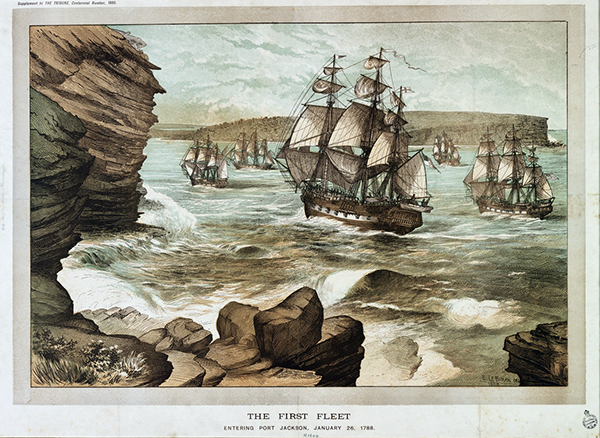
| Search JoyZine with Google Site Search! |
The First Fleet
Between 1788 and 1850 the English sent over 162,000 convicts to Australia in 806 ships. The first eleven of these ships are today known as the First Fleet and contained the convicts and marines that are now acknowledged as the Founders of Australia. This is their story.
Before 1788, Australia was populated by about 300,000 aborigines. These nomadic people had inhabited the world's oldest continent for more than 40,000 years. They had seen very few Europeans, but two events were to play an important part in changing their way of life forever. Captain James Cook discovered the east coast of New Holland in 1770 and named it New South Wales. He sailed the whole of the coast and reported to the British government that he thought it would make a good place for a settlement. Britain did not recognise the country as being inhabited as the natives did not cultivate the land, and were, therefore, "uncivilized". The land was declared Terra Nullius. The agrarian revolution in Britain, and the population explosion in the cities, resulted in an increase in crime. As the American Revolution meant that no more convicts could be sent there, the only way to overcome the overcrowding in the jails was to establish a penal colony in the land discovered by Captain James Cook. The convicts would be transported, never to return to Britain. With this in mind, the British Government hired 9 ships and set about provisioning them, together with 2 Naval vessels, with enough supplies to keep the 759 convicts, their Marine guards, some with families, and a few civil officers, until they became self-sufficient. The convicts and marines embarked on the ships, which arrived at Portsmouth on 16th March 1787. They then waited on board until the arrival of Captain Arthur Phillip signaled that the time for their departure had arrived. By the time they departed, some convicts had been aboard these ships for seven months. Very few convicts (23) died during the voyage compared to the later convict fleets. The First Fleet left England on 13th May 1787 for the 'lands beyond the seas,' i.e. Australia, stopping at Tenerife, Rio de Janeiro and Cape Town, where food supplies were replenished. The fleet arrived at Botany Bay between 18th and 20th January 1788. However, this area was deemed to be unsuitable for settlement due to its lack of fresh water. Botany Bay had other shortcomings as well: it was open to the sea, making it unsafe for the ships, and Captain Arthur Phillip (the Colony's first Governor) considered the soil around Botany Bay to be too poor for crop growing. The fleet sailed north, arriving at Port Jackson on the Australian east coast on 26 January 1788. From the start the settlement was beset with problems. Very few convicts knew how to farm and the soil around Sydney Cove was poor. Instead of Captain Cook's 'lush pastures, well watered and fertile ground', suitable for growing all types of foods and providing grazing for cattle, they found a hot, dry, unfertile country unsuitable for the small farming necessary to make the settlement self-sufficient. Everyone, from the convicts to Captain Phillip, was on rationed food from the government store. While the natives subsisted on local plants and fish, the settlers found few of the plants to be appetising. As the settlers appear to have been poor fishermen, most of their food had to come from the supplies brought with them on the ships. This resulted in their total dependence on a shipping trade monopolized by the East India Company and non-existent as far as Sydney was concerned. Rats, dogs, crows, an occasional kangaroo or emu were to be used to supplement the food. The natives were wary and fearful of the settlers, who referred to them as Indians. Some African-American convicts, hoping to be accepted by the natives, escaped but were rejected by them. Other convicts, heeding rumours of other settlements nearby and that China was just over the horizon, also escaped. Those that managed to survive the rigors of the country returned to the colony to further punishment. By July 1788, all the ships except the Naval vessels Syrius and Supply had left and the settlement was isolated. On 2nd October the Syrius was despatched to Cape Town, South Africa, to purchase provisions. Until her return on 2nd May 1789, rations were cut back with the result that work on farming and building was reduced even further. During this time the Supply had taken a small contingent of convicts and marines to Norfolk Island to set up another penal colony. The land there was pronounced more fertile than that of Sydney Cove and the timber of better quality, but the rocky cliffs surrounding the island meant that it could not be loaded on the ship for transport to Sydney Cove. Green turtles were found there and Supply brought a few back on its voyages from Norfolk Island, which helped to supplement the food in the Sydney Cove colony. The Fleet consisted of six convict ships, three store ships and two man-o-war ships, with a total of 756 convicts (564 male, 192 female), 550 officers/marines/ship crew and their families.
|
